Africatown Community Land Trust Celebrates the Opening of Africatown Plaza, a New Affordable Housing Building
On Saturday, Oct. 5, Africatown Community Land Trust celebrated the opening of Africatown Plaza, a new income-restricted affordable housing building located in the heart of the Central District. The 7-story, 126-unit building will house individuals and families earning up to 60% of the area median income (AMI) and is a result of ACLT’s partnership with affordable housing developer Community Roots Housing.
“All of this is the evidence of the power that we have — this project presents proof that we can be idealistic, optimistic, and pragmatic and get things done all at the same time. Proof of what happens when you don’t accept the future that someone else has scripted for you, when we embrace our own agency and power to shape the world that we live in,” said ACLT cofounder, president, and CEO K. Wyking Garrett at Africatown Plaza’s ribbon cutting and grand opening celebration.
The building, which has been in the works since 2008, was constructed in an effort to invite back Black families pushed out of the Central District due to market forces.
“The Central District was 70% Black families 20 years ago, [and] it’s 10% Black families today. ” said Rico Quirindongo, architect and director at the Office of Planning and Community Development for the City of Seattle. “Africatown has provided a vision and opportunity to start to bring families back — to not only provide a place for people to raise their families but to celebrate African American culture and place making, to not only ensure that there isn’t further displacement, but to actually reverse that number and to start to bring Black people back into the Central District that haven’t been able to afford to live here.”
Washington State Sen. Rebecca Saldaña also spoke at the grand opening celebration. “It has been over a decade of organizing to get to this moment and it’s an honor to be here to be able to witness what it looks like when we move from a white-centered, white supremacist model of doing politics in Washington State to one that centers Blackness, that centers our strength and our leadership of our communities, and also reminds us all that we’re standing on Coast Salish land,” she said.
State Rep. Chipalo Street was also in attendance and spoke about how projects like Africatown Plaza represent the capacity communities have to create concrete solutions to address their problems.
“We are training ourselves to solve the problems that we see in our community [by] doing things that people told us were not possible,” said Street. “[We are] building that capacity within this community — who are funneling money back into the community at the same time by hiring people who live here, Black architects and other folks who are involved in the building and development space — because we have a lot of great affordable housing developers, but we don’t always have affordable housing developers that mirror the communities in which they’re building housing.”
Guests were given guided tours of the building in groups. As guides ushered guests to the elevators, art honoring Seattle’s Black diaspora adorned the lobby’s walls to provide residents with representation of themselves and their history.
The first unit toured was a studio apartment on the fourth floor with floor-to-ceiling windows overlooking a view of the city. The unit was about 400 square feet and included a full kitchen with a stove and dishwasher.
Guests were also walked through a three-bedroom unit with a window in the master bedroom overlooking a view of Mount Rainier. Three-bedroom units for households at 60% AMI will cost a monthly rent of $2,037, less than the average cost of a non-income-restricted one-bedroom apartment in Seattle (according to Apartments.com), and are about 1,091 square feet.
Prosperity Now’s 2021 report, “The Racial Wealth Divide in Seattle,” outlines data showing the economic disparities between ethnic groups in Seattle that have led to the rapid gentrification of neighborhoods like the Central District. In 2020, the median household income (MHI) for the average Black family in Seattle was $39,936, followed only by Native American households with an MHI of $31,519.
That same year, the homeownership rate for Black families was the lowest of all racial demographics in Seattle at 25.8% compared to white families at 50.9%, Asian 43.2%, Native American 29.2%, and Latine 26.5% families.
It is these disparities that have aided in the destruction of Seattle’s historically Black neighborhood, inspiring ACLT to prevent further gentrification of the Central District by revitalizing the once majority-Black area.
“[This is] proof of what happens when we embrace the idea that the best way to predict the future is to create it,” said Garrett. “From the Liberty Bank Building to Midtown to the renaissance of Black culture, commerce, and community that is happening throughout the Central District — this is our proof of what happens when you invest in the vision and the work of Africatown.”
Help keep BIPOC-led, community-powered journalism free — become a Rainmaker today.


